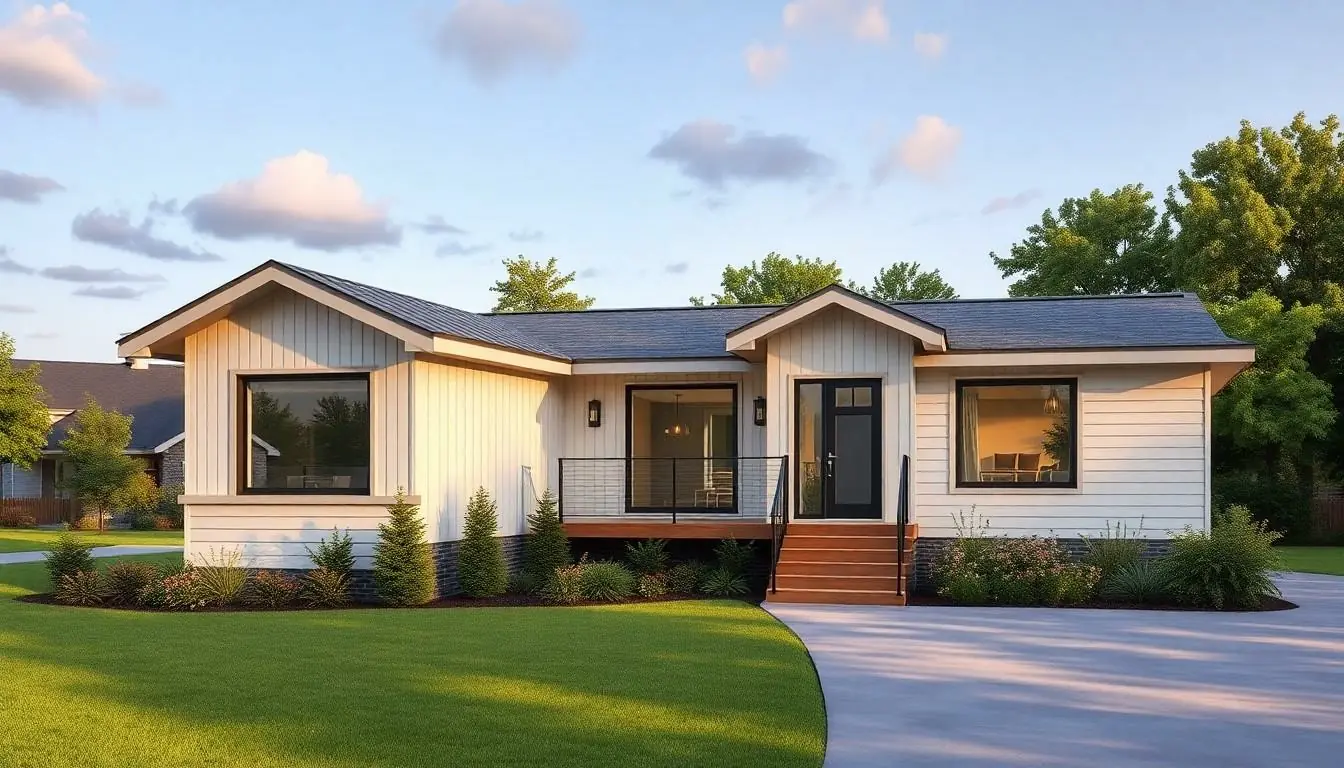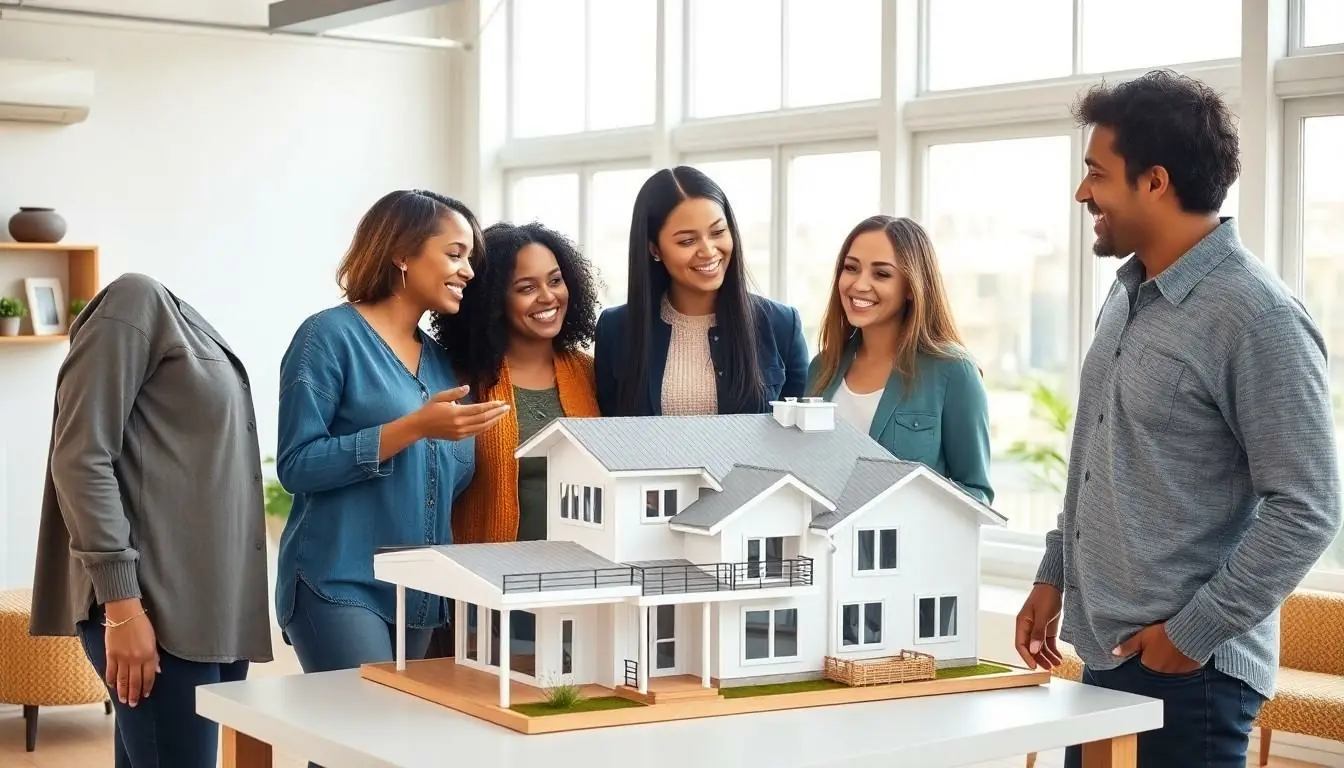In a world where cookie-cutter homes reign supreme, modular home design swoops in like a superhero with a cape made of customizable charm. Think of it as the IKEA of the housing market—only without the confusing instructions and missing screws. Modular homes offer a fresh twist on traditional living, allowing homeowners to mix and match styles, layouts, and finishes to create their dream abode.
Imagine a home that’s as unique as your taste in socks. With modular design, flexibility is the name of the game. Whether it’s a cozy cottage or a modern masterpiece, these homes adapt to fit lifestyles, budgets, and even whims. So, if you’re tired of the same old square boxes, it’s time to explore the exciting world of modular homes—where creativity meets construction in a delightful dance of innovation.
Table of Contents
ToggleOverview of Modular Home Design
Modular home design represents a modern alternative to traditional housing, emphasizing adaptability and individuality. This construction method entails prefabricating sections of the home in a factory setting before transporting them to the building site for assembly. Homeowners enjoy the ability to customize various aspects including layouts, materials, and finishes, aligning their living spaces with personal preferences.
Customization options in modular homes are extensive. Homeowners can select floor plans to accommodate families or create versatile spaces for entertaining. They often find these choices appealing, as modular homes can adapt to diverse lifestyles and needs.
Efficiency is another key benefit of modular home design. The streamlined construction process typically reduces build time compared to traditional homes. This efficiency translates into cost savings, with homeowners often enjoying lower labor costs and quicker occupancy.
Quality control in factory settings further enhances modular home reliability. Builders implement strict standards during production, ensuring that each modular unit is constructed to withstand various environmental factors. This quality assurance fosters confidence among buyers, knowing their homes meet high performance standards.
Sustainability also plays a significant role in modular home design. Many manufacturers prioritize eco-friendly materials and energy-efficient technologies, allowing homeowners to minimize their carbon footprint. This focus on sustainability responds to the increasing demand for environmentally responsible living options.
A growing trend in modular homes reflects current preferences for minimalist and functional design. Consumers increasingly seek spaces that embody simplicity without sacrificing comfort or style. This shift resonates with those looking for innovative solutions in home design, affirming the relevance of modular construction in today’s housing market.
Benefits of Modular Home Design

Modular home design offers various advantages, appealing to homeowners seeking individuality and efficiency. Key benefits include cost-effectiveness, time efficiency, and a positive environmental impact.
Cost-Effectiveness
Modular homes present significant savings in construction costs. Prefabrication in a factory setting minimizes expensive on-site labor, resulting in lower overall expenses. Buyers often enjoy reduced waste due to streamlined production processes. Many manufacturers also provide energy-efficient features, leading to lower utility bills over time. Additionally, customizable designs help homeowners avoid unnecessary expenses, as they can focus on essential features and materials.
Time Efficiency
Time efficiency ranks high among modular home advantages. Factory construction allows for simultaneous site preparation and module fabrication, which accelerates the overall timeline. Homeowners often move in months earlier compared to traditional builds. Weather interruptions affecting on-site construction pose less of a risk in factory settings, ensuring consistent progress. Even complex designs can be completed on a tight schedule due to systematic assembly techniques.
Environmental Impact
Environmental considerations play a crucial role in modular home design. Manufacturers often prioritize sustainable materials and methods in their building practices. Energy-efficient technologies reduce the overall carbon footprint, benefiting both homeowners and the planet. Less waste generated during the construction process enhances the environmental appeal of modular homes. Many designs also incorporate green technology, common among newer models, allowing for a more responsible living option.
Key Features of Modular Home Design
Modular home design offers various features that set it apart from traditional homes, granting homeowners flexibility and efficiency.
Customization Options
Homeowners enjoy extensive customization options in modular designs. Numerous styles and layouts allow personal expression to take center stage. Finishes range from modern to rustic, catering to diverse tastes. Homeowners can choose everything from siding materials to interior cabinet colors. Additionally, the flexibility in design ensures functionality meets individual needs, optimizing space for specific lifestyles.
Sustainability Practices
Sustainability is a central focus in modular home construction. Many manufacturers incorporate eco-friendly materials, minimizing environmental impact. Use of energy-efficient technologies, including high-performance windows and insulation, promotes reduced utility costs. Effective waste management practices during construction further support environmental goals. By choosing modular homes, homeowners engage in responsible living that aligns with current sustainability trends.
Challenges in Modular Home Design
Modular home design, while innovative, faces certain challenges that can complicate the process for homeowners.
Financing and Insurance
Securing financing for modular homes presents unique obstacles. Some lenders remain hesitant due to misconceptions about modular construction. It’s essential for buyers to research lenders familiar with this type of home. Insurance can also pose challenges, as not all providers offer policies tailored to modular homes. Homeowners should understand the differences in coverage compared to traditional homes. Working with agents experienced in modular home insurance can aid in finding appropriate coverage.
Zoning and Permitting Issues
Zoning and permitting concerns often arise during the modular home purchasing process. Local regulations frequently dictate land use, which can affect where homeowners place modular homes. Restrictions may limit the type or size of structures allowed. Additionally, obtaining necessary permits can involve lengthy processes. Homeowners should familiarize themselves with local zoning laws before making a purchase. Engaging a knowledgeable contractor or architect can help navigate these complexities and ensure compliance with regulations.
Future Trends in Modular Home Design
Innovations in modular home design reflect evolving consumer preferences and technological advancements. Increased integration of smart home technology enables homeowners to control lighting, security, and climate efficiently. Enhanced connectivity improves convenience and energy management within modular homes.
Sustainability remains a priority in future designs. Manufacturers are focusing on using recycled and eco-friendly materials while committing to energy-efficient practices. Modular homes increasingly include features like solar panels and high-performance insulation, further reducing their carbon footprint.
A shift toward flexible living spaces is also evident. Open floor plans, adaptable furniture, and multifunctional areas respond to the needs of modern families. These designs encourage collaboration and social interaction while maximizing space efficiency.
Minimalism continues to influence modular aesthetics. Simple lines and neutral color palettes create calming environments conducive to relaxation. Homeowners are gravitating toward designs that prioritize simplicity without compromising comfort.
Collaboration with architects and designers emerges as a vital trend. Partnerships lead to innovative approaches that meet diverse needs, pushing the boundaries of traditional modular home design. Customization options allow homeowners to tailor their spaces to match personal styles while incorporating cutting-edge trends.
Lastly, affordability remains key. As demand for modular homes rises, competition among manufacturers drives down prices. Increased accessibility encourages more individuals to explore modular living as a viable alternative to traditional housing.
These trends collectively indicate a dynamic future for modular home design, uniting flexibility, sustainability, and innovation to meet the demands of tomorrow’s homeowners.
Modular home design stands out as a forward-thinking solution for those seeking flexibility and sustainability in their living spaces. With extensive customization options and a focus on eco-friendly practices, these homes cater to modern preferences for individuality and efficiency.
As technology and consumer demands evolve, modular homes are poised to embrace smart innovations and adaptable designs that maximize both comfort and functionality.
The potential for reduced construction times and costs further enhances their appeal, making modular homes a practical choice for today’s homeowners. As interest in this innovative housing option grows, it’s clear that modular design will play a significant role in shaping the future of residential living.






